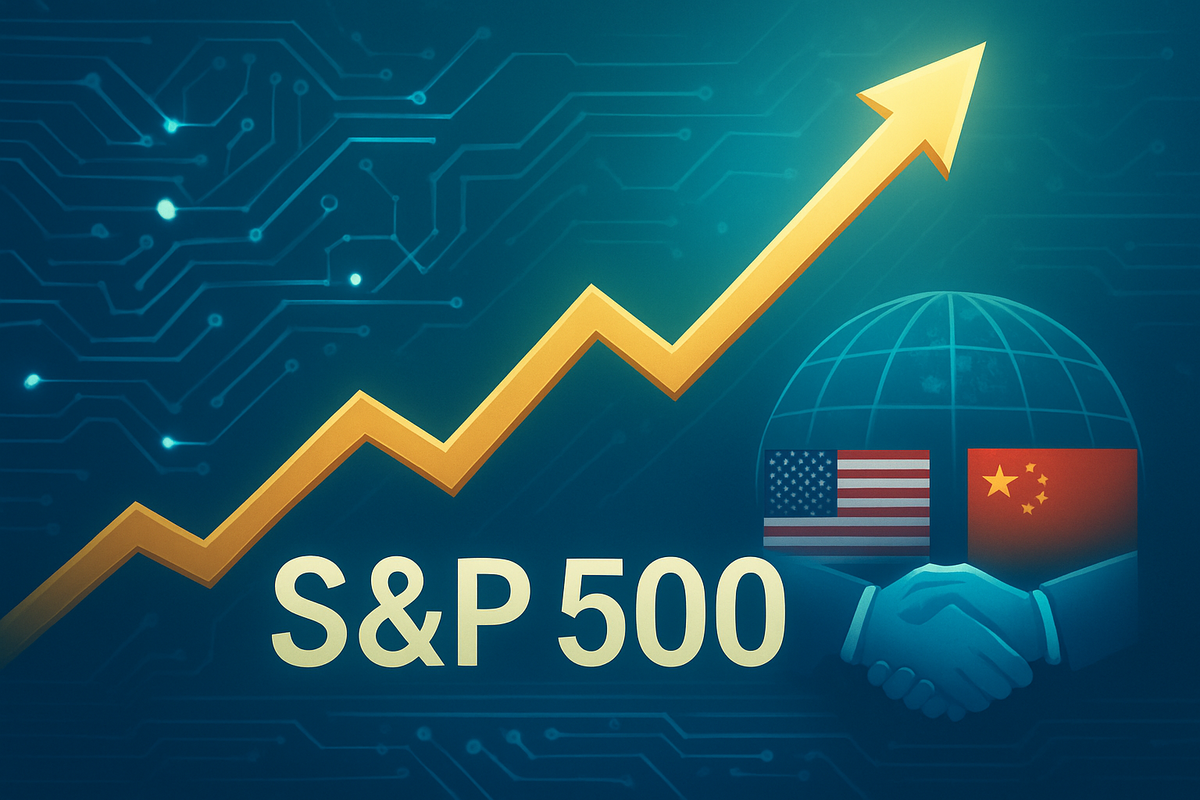
New York, NY – October 27, 2025 – The S&P 500 index has shattered previous records, surging to an all-time high and marking its 34th record close of the year. This monumental rally, which saw the benchmark index touch an intraday record of 6,850 and close Friday, October 24, 2025, at 6,791.69, signals a period of profound optimism in the financial markets. The ascent is not isolated, with both the Dow Jones Industrial Average and the Nasdaq Composite also reaching fresh all-time highs, painting a picture of broad-based market strength.
This historic climb is underpinned by a confluence of powerful economic and corporate tailwinds. Robust earnings from technology giants, fueled by the burgeoning artificial intelligence (AI) revolution, have been a primary catalyst. Simultaneously, renewed hopes for a U.S.-China trade truce and increasing expectations for Federal Reserve rate cuts in early 2026 have injected significant confidence, easing concerns over global supply chains and borrowing costs. For investors, this moment presents a complex landscape of continued growth potential alongside underlying concerns about market valuations and the sustainability of the current momentum.
The Unprecedented Ascent: A Closer Look at the S&P 500's Record-Breaking Run
The S&P 500's journey to new record highs has been a defining narrative of 2025. The index's consistent upward trajectory, culminating in its latest milestone on October 24, 2025, reflects a resilient market environment. This rally has been notably driven by several interconnected factors, creating a powerful bullish cycle.
A significant portion of this surge can be attributed to the stellar performance of the technology sector, particularly companies deeply entrenched in artificial intelligence. Earnings reports from tech behemoths have consistently exceeded expectations, with nearly 70% of S&P 500 companies beating Q3 earnings estimates and an impressive 87% reporting actual earnings per share (EPS) above projections. Companies like Qualcomm (NASDAQ: QCOM), Nvidia (NASDAQ: NVDA), Advanced Micro Devices (NASDAQ: AMD), Apple (NASDAQ: AAPL), Alphabet (NASDAQ: GOOGL), and Microsoft (NASDAQ: MSFT) have been at the forefront, with Qualcomm's 13% jump following its new AI-powered Snapdragon chips being a prime example of the market's enthusiasm for AI innovation.
Adding to the bullish sentiment are growing expectations of a U.S.-China trade truce. Reports circulating that Washington and Beijing are exploring a limited rollback of trade tariffs ahead of a planned meeting between President Donald Trump and Chinese President Xi Jinping have significantly eased geopolitical tensions. This potential de-escalation is perceived as a major boon for global trade and corporate profitability, reducing uncertainty that has plagued international markets for years. Furthermore, cooler-than-anticipated September Consumer Price Index (CPI) data has reinforced market expectations for the Federal Reserve to initiate rate cuts, potentially by early 2026. This prospect of lower borrowing costs has particularly bolstered growth stocks and fostered a "risk-on" investment climate.
Initial market reactions to these combined drivers have been overwhelmingly positive, characterized by strong buying interest and a drop in the CBOE Volatility Index (VIX) below 12, signaling robust market confidence. Despite this, a sense of "reluctant bullishness" pervades, with some investors participating in the rally but harboring concerns about valuations and the potential for an AI bubble reminiscent of the dot-com era. The market remains keenly attuned to upcoming economic data, the outcome of U.S.-China trade talks, and the Federal Reserve's monetary policy decisions, recognizing that any negative surprises could trigger a near-term pullback.
Corporate Fortunes: Winners and Losers in the S&P 500's Ascent
The S&P 500's rally to new record highs has created clear beneficiaries while also posing potential challenges for certain sectors and companies. The primary winners are undoubtedly the mega-cap technology and AI-focused firms that have spearheaded much of the market's growth.
Companies like Nvidia (NASDAQ: NVDA), Qualcomm (NASDAQ: QCOM), and Advanced Micro Devices (NASDAQ: AMD), deeply embedded in the AI hardware and chip manufacturing ecosystem, are experiencing significant gains. Their robust earnings and groundbreaking innovations in AI processing power are driving demand and investor confidence. Similarly, software and cloud computing giants such as Microsoft (NASDAQ: MSFT) and Alphabet (NASDAQ: GOOGL), which are integrating AI across their product suites and cloud services, are seeing increased revenue streams and elevated valuations. Apple (NASDAQ: AAPL), with its vast ecosystem and ongoing integration of AI into its devices and services, also stands to benefit from sustained consumer spending and technological advancements. These companies are not only seeing their stock prices climb but are also leveraging their market capitalization to invest further in research and development, potentially cementing their long-term dominance.
On the other hand, the rally, while broad, might inadvertently create headwinds for other segments. Companies with high debt loads, while temporarily benefiting from stabilized Treasury yields, could face renewed pressure if interest rate expectations shift or if economic growth falters unexpectedly. Sectors that are less exposed to the technology and AI boom might see their relative valuations lag, making it harder to attract capital in a market heavily focused on growth narratives. Furthermore, the concentration of market gains in a few mega-cap tech stocks raises concerns about market breadth. If these leading stocks were to experience a significant correction, the ripple effect could be substantial, impacting diversified portfolios and potentially exposing companies with weaker fundamentals that have been buoyed by the overall market sentiment.
The prospect of a U.S.-China trade truce is a net positive for many multinational corporations, particularly those in manufacturing, consumer goods, and technology that rely on global supply chains and access to both markets. Reduced tariffs and improved trade relations could boost profit margins and expand market access, turning previous losers into potential winners. However, companies that have successfully navigated trade tensions by re-shoring operations or diversifying supply chains might see some of their competitive advantages diminish if global trade normalizes significantly. Ultimately, the sustained rally rewards innovation, market leadership, and adaptability, while those unable to capitalize on current trends or vulnerable to macroeconomic shifts may find themselves in a more challenging position.
Wider Significance: A New Era of Market Dynamics
The S&P 500's rally to unprecedented highs signifies more than just a momentary surge; it points to a potentially new era of market dynamics shaped by technological advancement, evolving geopolitical landscapes, and refined monetary policy. This event fits squarely into broader industry trends emphasizing artificial intelligence as a transformative force, akin to the internet revolution of the late 1990s. The aggressive investment and rapid innovation in AI are not just confined to tech giants but are now permeating various sectors, from healthcare and finance to manufacturing, promising efficiency gains and new product development across the economy.
The ripple effects of this rally are substantial. Competitors in every industry are now compelled to accelerate their AI strategies to remain relevant, potentially leading to increased R&D spending and strategic partnerships. Companies that fail to adapt risk being left behind, while those that successfully integrate AI could see significant competitive advantages. Partners within the tech ecosystem, such as data centers, cloud service providers, and specialized component manufacturers, are also experiencing a boom, as the infrastructure supporting AI development scales rapidly. This creates a virtuous cycle of investment and growth, but also raises concerns about market concentration and potential bottlenecks.
Regulatory implications are beginning to emerge as well. Governments worldwide are grappling with how to regulate AI, focusing on areas like data privacy, ethical AI development, intellectual property, and market dominance. The sheer speed of AI advancement means that regulatory frameworks are often playing catch-up, and future policies could significantly impact the operational freedom and profitability of leading AI companies. The potential U.S.-China trade truce, if solidified, would also have profound policy implications, potentially reshaping global trade agreements and fostering greater economic interconnectedness, though long-term strategic competition between the two economic powers is likely to persist.
Historically, periods of rapid technological advancement and market euphoria, such as the dot-com bubble of 1999, offer cautionary tales. While the current AI-driven rally shares some characteristics with past bubbles—namely, high valuations and intense speculative interest—there are critical differences. Today's leading tech companies often boast robust revenue streams, established market positions, and tangible products, distinguishing them from many of the unprofitable dot-com startups of yesteryear. However, the sheer pace of capital flowing into AI and the rapid appreciation of related assets warrant careful observation to ensure that valuations remain tethered to fundamentals.
What Comes Next: Navigating the Future of the S&P 500
Looking ahead, the S&P 500's trajectory will be influenced by a complex interplay of technological innovation, macroeconomic shifts, and geopolitical developments. In the short term, market participants anticipate continued bullish momentum, with some technical analyses pointing towards a potential rally towards the 7,075 level for the S&P 500. However, the immediate future is also fraught with potential volatility, especially given the high-stakes U.S.-China trade talks, upcoming Federal Reserve monetary policy decisions, and the continuous flow of Big Tech earnings reports. Any unexpected negative news from these fronts could trigger a market pullback, testing the resilience of the current rally.
Long-term possibilities for the market are largely tied to the sustained growth and widespread adoption of artificial intelligence. As AI matures, it is expected to drive productivity gains across industries, create new markets, and fundamentally reshape existing business models. This presents significant market opportunities for companies that can effectively integrate AI into their operations and product offerings, as well as for those providing the foundational infrastructure for AI development. Conversely, companies that fail to innovate or adapt to the AI paradigm risk obsolescence, facing challenges in maintaining market share and profitability.
Potential strategic pivots or adaptations will be crucial for companies and investors alike. Businesses will need to continually reassess their R&D priorities, talent acquisition strategies, and supply chain resilience in a rapidly evolving technological and geopolitical landscape. Investors, meanwhile, may need to re-evaluate their portfolio allocations, balancing exposure to high-growth AI stocks with more defensive assets, especially if concerns about valuation bubbles intensify. The market may also see increased M&A activity as larger players seek to acquire innovative AI startups or consolidate their market positions.
Several scenarios could unfold. A "soft landing" scenario, where inflation continues to cool, the Fed implements measured rate cuts, and AI drives sustained economic growth, would likely see the S&P 500 continue its upward trajectory, albeit with periodic corrections. Conversely, a scenario involving a resurgence of inflation, a more hawkish Fed, or significant geopolitical instability could lead to a more substantial market downturn. The emergence of unforeseen regulatory hurdles for AI or a slowdown in the U.S.-China trade truce negotiations could also introduce headwinds. Ultimately, the market will remain highly sensitive to incoming data and news, requiring investors to stay agile and informed.
A New Market Paradigm: Enduring Impact and Investor Vigilance
The S&P 500's rally to new record highs marks a pivotal moment in financial history, driven by the transformative power of artificial intelligence, a thawing in U.S.-China trade relations, and the anticipation of more accommodative monetary policy. The key takeaway from this event is the profound influence of technological innovation on market performance, with AI emerging as a dominant force shaping corporate fortunes and investor sentiment. This period highlights a market that, while bullish, remains acutely sensitive to macroeconomic data and geopolitical shifts, reflecting a blend of euphoric positioning and underlying caution among investors.
Moving forward, the market is likely to remain dynamic and potentially volatile. The assessment of corporate earnings, particularly from the heavily weighted technology sector, will continue to be a critical determinant of market direction. The delicate balance between aggressive growth and sustainable valuations will be a recurring theme, especially as discussions around an "AI bubble" gain traction. The long-term impact of this rally could be a fundamental re-calibration of economic productivity and corporate efficiency, driven by AI integration across diverse industries, potentially ushering in a new era of sustained, technology-led growth.
For investors, the coming months will demand heightened vigilance. Key indicators to watch include further inflation data and the Federal Reserve's statements on interest rate policy, as these will directly impact borrowing costs and corporate profitability. Developments in U.S.-China trade negotiations will also be crucial, as a definitive truce or renewed tensions could significantly sway global market sentiment. Furthermore, investors should closely monitor the earnings performance and innovation pipelines of leading AI companies, as their success will largely dictate the continued health of the broader market. While the current environment presents opportunities for growth, a disciplined approach, focusing on diversified portfolios and fundamental analysis, will be essential to navigate the evolving market landscape successfully.
This content is intended for informational purposes only and is not financial advice







